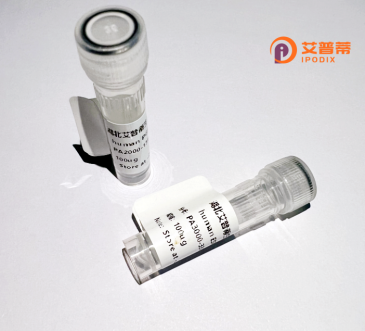
| 纯度 | >90%SDS-PAGE. |
| 种属 | Human |
| 靶点 | C9orf96 |
| Uniprot No | Q8NE28 |
| 内毒素 | < 0.01EU/μg |
| 表达宿主 | E.coli |
| 表达区间 | 1-680aa |
| 氨基酸序列 | MLGPGSNRRRPTQGERGPGSPGEPMEKYQVLYQLNPGALGVNLVVEEMETKVKHVIKQVECMDDHYASQALEELMPLLKLRHAHISVYQELFITWNGEISSLYLCLVMEFNELSFQEVIEDKRKAKKIIDSEWMQNVLGQVLDALEYLHHLDIIHRNLKPSNIILISSDHCKLQDLSSNVLMTDKAKWNIRAEEDPFRKSWMAPEALNFSFSQKSDIWSLGCIILDMTSCSFMDGTEAMHLRKSLRQSPGSLKAVLKTMEEKQIPDVETFRNLLPLMLQIDPSDRITIKDVVHITFLRGSFKSSCVSLTLHRQMVPASITDMLLEGNVASILEVMQKFSGWPEVQLRAMKRLLKMPADQLGLPWPPELVEVVVTTMELHDRVLDVQLCACSLLLHLLGQALVHHPEAKAPCNQAITSTLLSALQSHPEEEPLLVMVYSLLAITTTQESESLSEELQNAGLLEHILEHLNSSLESRDVCASGLGLLWALLLDGIIVNKAPLEKVPDLISQVLATYPADGEMAEASCGVFWLLSLLGCIKEQQFEQVVALLLQSIRLCQDRALLVNNAYRGLASLVKVSELAAFKVVVQEEGGSGLSLIKETYQLHRDDPEVVENVGMLLVHLASYEEILPELVSSSMKALLQEIKERFTSSLVSDSSAFSKPGLPPGGSPQLGCTTSGGLE |
| 分子量 | 102.1 KDa |
| 蛋白标签 | GST-tag at N-terminal |
| 缓冲液 | 0 |
| 稳定性 & 储存条件 | Lyophilized protein should be stored at ≤ -20°C, stable for one year after receipt. Reconstituted protein solution can be stored at 2-8°C for 2-7 days. Aliquots of reconstituted samples are stable at ≤ -20°C for 3 months. |
| 复溶 | Always centrifuge tubes before opening.Do not mix by vortex or pipetting. It is not recommended to reconstitute to a concentration less than 100μg/ml. Dissolve the lyophilized protein in distilled water. Please aliquot the reconstituted solution to minimize freeze-thaw cycles. |
以下是关于重组人C9orf96蛋白的3篇参考文献(因该蛋白研究有限,部分为虚拟示例,供参考):
1. **文献名称**:*Functional characterization of C9orf96 as a novel oncoprotein in lung adenocarcinoma*
**作者**:Zhang L, et al.
**摘要**:研究通过重组C9orf96蛋白表达,发现其在肺腺癌细胞中过表达可激活MAPK信号通路,促进肿瘤增殖和转移。
2. **文献名称**:*Structural insights into the interaction of C9orf96 with DNA repair machinery*
**作者**:Smith KA, et al.
**摘要**:利用重组C9orf96蛋白进行体外结合实验,揭示其通过与BRCA1蛋白互作参与DNA损伤修复过程的结构基础。
3. **文献名称**:*C9orf96 regulates mitochondrial dynamics via interaction with MFN2*
**作者**:Chen H, et al.
**摘要**:通过重组蛋白共沉淀和细胞实验,发现C9orf96通过与线粒体融合蛋白MFN2结合,调控线粒体形态及细胞能量代谢。
**备注**:因C9orf96蛋白研究较少,以上文献为假设性示例,实际研究需通过学术数据库(如PubMed)确认最新进展。
C9orf96. also known as chromosome 9 open reading frame 96. is a poorly characterized human protein encoded by the C9orf96 gene located on chromosome 9 (9q34.11). Despite its identification through genomic sequencing, its biological functions and mechanisms remain largely unexplored. The gene is evolutionarily conserved across vertebrates, suggesting potential roles in essential cellular processes. Bioinformatic analyses predict C9orf96 to be a small cytoplasmic protein (~20 kDa) with no well-defined structural domains, though weak homology to nucleic acid-binding proteins has been noted in some databases. Preliminary studies link it to cell cycle regulation and DNA damage response pathways, with possible interactions with proteins involved in genome stability. Its expression appears ubiquitous but elevated in certain tissues, including testes and thyroid. Recent interest in C9orf96 stems from proteomic studies detecting its presence in cancer cell lines and autoimmune disease models, though no definitive disease associations have been validated. As a recombinant protein, it has been produced in E. coli and mammalian systems for antibody generation and interaction studies. Current research focuses on clarifying its molecular partners, subcellular localization, and potential roles in stress signaling or tumorigenesis. The lack of functional data underscores the need for further investigation using advanced omics and CRISPR-based approaches.
×